Only Freshwater Jellyfish can survive in freshwater, but not in pure freshwater.
Despite the common belief that they only exist in the ocean, various jellyfish species also live in freshwater environments (such as rivers and lakes). These freshwater jellyfish have adapted to their habitat. They can endure conditions that differ from those of their oceanic counterparts.
In this article, I will discuss freshwater jellyfish’s challenges and their survival process. Let’s dive into the fascinating world of freshwater jellyfish.
Do Jellyfish Live in Saltwater Or Freshwater?
Jellyfish can be found in both saltwater and freshwater environments. However, only a small percentage of jellyfish species can survive in freshwater.
These freshwater species are not as common as their saltwater counterparts but can still be found in different parts of the world.
In some freshwater habitats, freshwater jellyfish can form dense populations. This adds to the diversity and complexity of aquatic ecosystems.
Do Jellyfish Need Saltwater?
Jellyfish require saltwater to survive. The salt concentration in the water, or salinity, is crucial to their survival. Most jellyfish require a salinity level of at least 0.6 to 1.0 parts per thousand (ppt) to live. Some species, such as the lion’s mane jellyfish, up to 5 ppt.
Freshwater jellyfish also require some level of salt concentration to survive. However, they can tolerate lower salinity levels than saltwater jellyfish. They still need at least 0.25 ppt of salt in the water to survive.
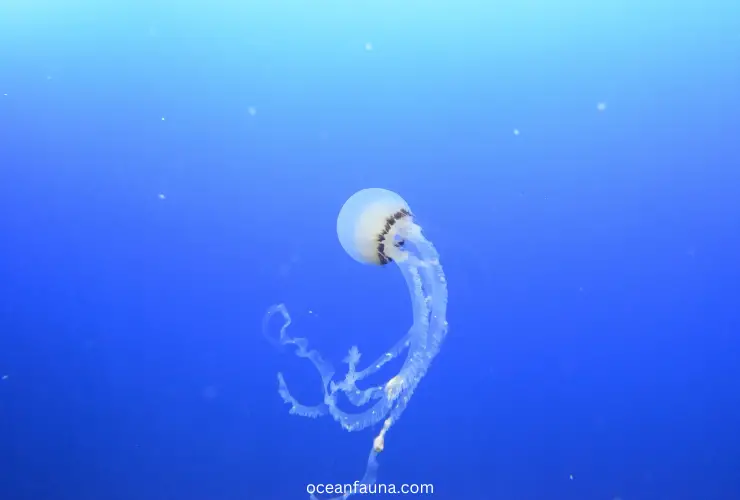
Some freshwater jellyfish species (Craspedacusta sowerbyi), can tolerate salinity levels up to 0.5 ppt. If the salinity levels drop below the minimum required level, the jellyfish may struggle to maintain their bodily functions and eventually die.
Can Jellyfish Live in Tap Water?
Jellyfish cannot survive in tap water. They require specific conditions such as saltwater, proper oxygen levels, and appropriate temperature to survive.
Tap water has a different pH, salinity, and temperature than the natural habitats of jellyfish. This makes tap water unsuitable for them to live in.
If you want to pet jellyfish in an aquarium, you must prepare a perfect living for your fish. Otherwise, they will die in days.
Eating habits of Freshwater Jellyfish
What Do Freshwater Jellyfish Eat? Freshwater jellyfish are typical, ranging from about 2 to 25 millimeters in diameter. They feed on small aquatic organisms, such as zooplankton, small crustaceans, and other small aquatic invertebrates.
They use their tentacles to capture their prey. The tentacles have stinging cells called nematocysts. It is their weapon to immobilize their prey. Once the prey is immobilized, the jellyfish uses its tentacles to bring the prey to its mouth, where it is ingested.
Lifespan of Freshwater Jellyfish
How long do freshwater jellyfish live? Freshwater jellyfish have a lifespan of around 12 to 18 months. Their life cycle can vary depending on water temperature and food availability.
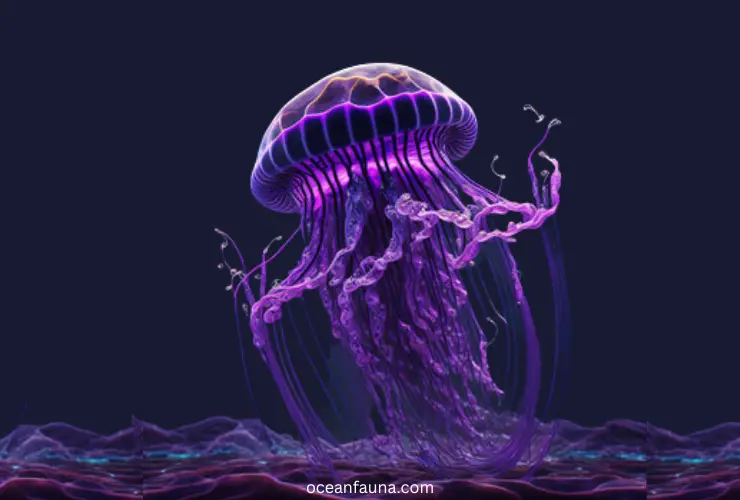
Craspedacusta sowerbyi lives for about 12 to 18 months and has a unique life cycle involving a polyp and a medusa stage. During the polyp stage, they attach to objects in the water and reproduce asexually by budding off small jellyfish.
These small ocean creatures then mature into the medusa stage, swimming freely in the water and reproducing sexually.
They mainly reside in still or slowly moving freshwater environments like ponds and lakes. They are small (2.5 cm in diameter) and eat zooplankton and copepods.
The Common Habitat of Freshwater Jellyfish
Where are freshwater jellyfish found? Well, freshwater jellyfish have been reported in various freshwater habitats worldwide. In the United States, you will find them in the following states:
- California
- Colorado
- Maine
- Massachusetts
- Michigan
- New Hampshire
- New Jersey
- New York
- Pennsylvania and
- Vermont.
China has also reported freshwater jellyfish in many parts of the country, such as the Yangtze River and the Poyang Lake.
You will find them in several freshwater bodies in Japan, including Lake Biwa (the largest freshwater lake in Japan).
Australia has reported freshwater jellyfish in Lake Alexandrina in South Australia and the Yarra River in Victoria.
Additionally, freshwater jellyfish have been found in several European countries, including.
- Germany
- The Czech Republic
- Poland.
Recently freshwater jellyfish have been found in Turkey and the United Kingdom!
How Do Freshwater Jellyfish Get into Lakes?
There are a few possible ways for jellyfish to get into freshwater lakes. Here is a description of some important insights:
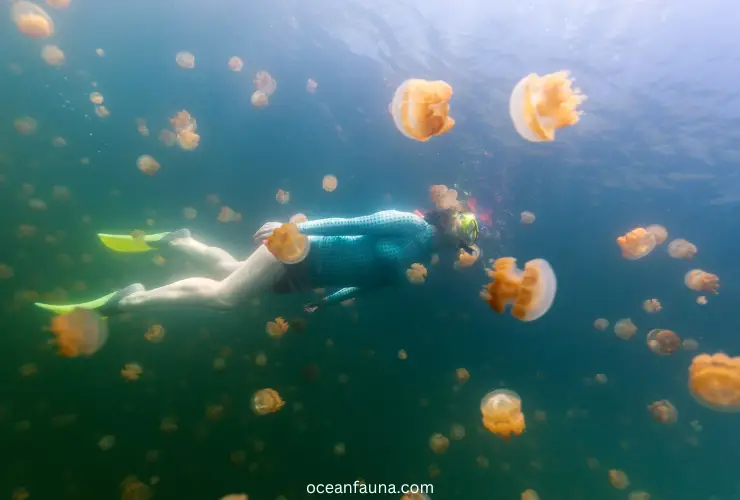
1. Natural dispersal:
Freshwater jellyfish can move from one body of water to another through natural dispersal mechanisms. Adult jellyfish can release small, free-swimming larvae called planulae.
Planulae can float in the water and be carried by currents and winds to new locations. Once they settle in a suitable environment, the planulae can develop into juvenile jellyfish and grow into adult individuals.
2. Human-mediated introductions:
Another way freshwater jellyfish can get into lakes is through human activities. People may intentionally or accidentally introduce jellyfish into new environments by transporting them in boats, fishing gear, or other equipment.
They can also hitch a ride on other aquatic organisms like snails or fish and move from one place to another. These marine creatures can establish new populations if they find a suitable habitat and food source.
3. Natural range expansions:
Some freshwater jellyfish may have natural ranges that include quarries, reservoirs and even rivers and slow streams. These jellyfish can expand their distribution by moving through connecting waterways or adapting to new environmental conditions.
If a lake becomes more alkaline or warmer due to climate change or human activities, it may become a more suitable habitat for certain jellyfish species.
Can You Keep Freshwater Jellyfish?
Yes, it is possible to keep freshwater jellyfish in captivity. To keep freshwater jellyfish, you will need an aquarium or container with a volume of at least a few gallons.
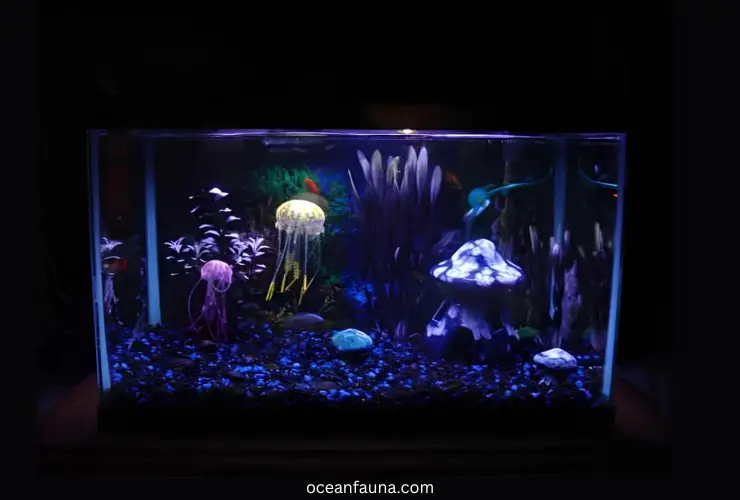
The water in the tank should be clean and free of contaminants. Salinity should range between 1-1.5. A neutral pH (around 7.0) is advised.
The temperature should be between 18-24°C (64-75°F), and a low flow rate is recommended to prevent the jellyfish from getting sucked into filters or pumps.
Types of Freshwater Jellyfish
Only one species of jellyfish is found exclusively in freshwater environments. It is Craspedacusta sowerbyi. Other species of jellyfish( Aurelia aurita) can occasionally be found in freshwater environments. They are primarily found in saltwater, though.
Craspedacusta sowerbyi key facts:
- Bell diameter: 1 centimeter (approx.)
- Habitat: Slow-moving or stagnant bodies of freshwater, such as ponds, lakes, and reservoirs
- Distribution: Native to several regions around the world, including North America, Europe, Asia, and Australia
- Prey: Small crustaceans and other zooplankton
- Sting: Mild and typically not harmful to humans
FAQs
Do jellyfish like hot or cold water?
Jellyfish are known to live both in hot and cold water. Box jellyfishes are the one species that prefer temperatures around 20-30 celsius. But other species don’t like warmer conditions and can not survive high temperatures.
The water temperature in the north Atlantic stays between 0-20 degrees Celsius. Lion jellyfishes live in those areas with comfort. But the water temperature should be kept at 20-22 degrees Celsius for petting jellyfish in fish tanks.
Can moon jellyfish live in freshwater?
Moon jellyfishes are well-known saltwater jellyfish. But nowadays, they are getting popular in aquariums. They need more salinity in the water compared to Craspedacusta sowerbyi to survive. So mixing saltwater with freshwater is the key to keeping them alive in your fish tank. The temperature should be kept somewhere between 15-21 degrees Celsius.
Can box jellyfish live in freshwater
Box jellyfishes mostly live in the ocean. But they can adapt to hazardous nature and can be found in freshwater. Research has found box jellyfish’s ability to survive in lakes. This is a rare sight, though. Jellyfish habitat needs more studies to understand correctly.
Can saltwater jellyfish live in freshwater?
No, most saltwater jellyfish cannot survive in freshwater. Their bodies are adapted to the specific salinity of saltwater and cannot regulate their internal salt levels in freshwater.
Conclusion
Jellyfish are actually saltwater animals. It is found in every ocean of the world. But there are plenty of places where jellyfish are found in freshwater. This does not change the fact that jellyfish being an ocean creatures.
These days a lot of people have jellyfish as their pets. They make the water condition and food availability appropriate for jellyfish to live. Additionally, you will find them in lower salinity and new lakes are discovered with these jellyfish daily!
Surely more studies and research will clarify doubts about how exactly jellyfish adapt in lakes and how they come in freshwater.

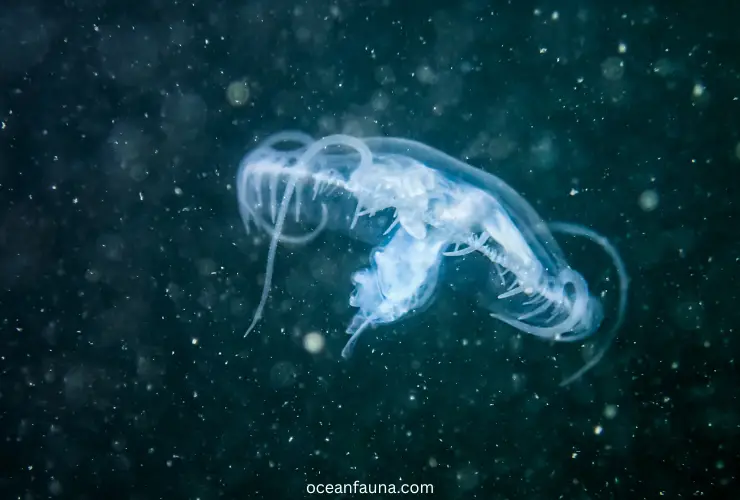
3 thoughts on “Can Jellyfish Live In Freshwater? The Survival Challenge”